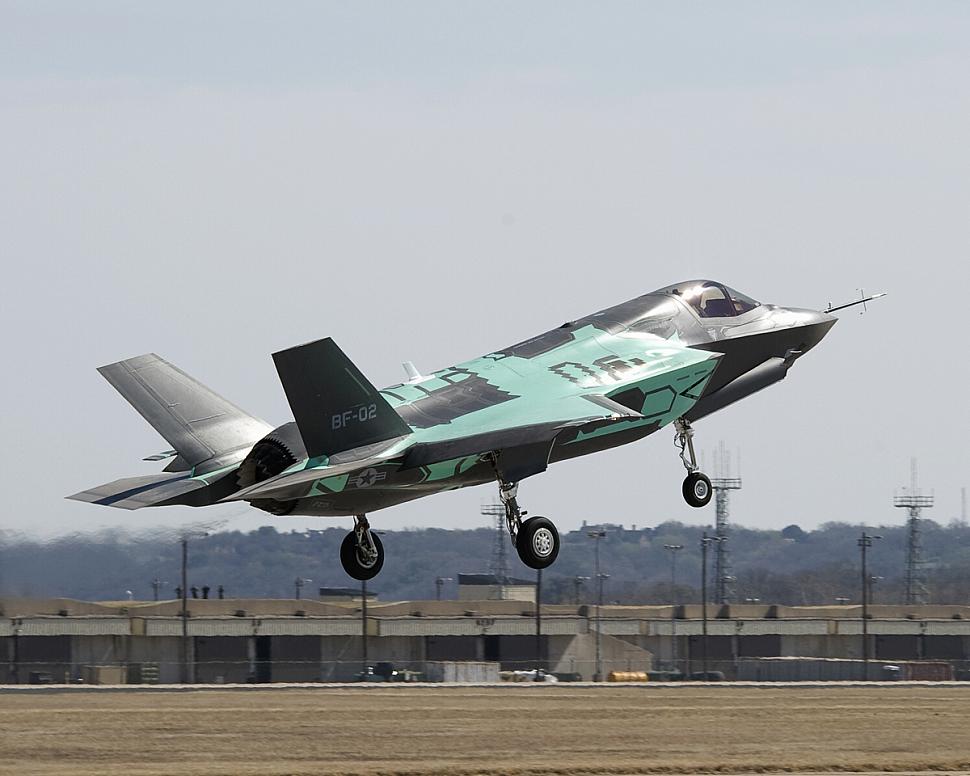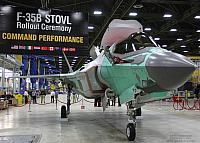Fighter Jet News
F-35 Lightning II News
Second F-35B STOVL achieves succesful first flight
February 26, 2009 (by
Lieven Dewitte) -
The second short takeoff/vertical landing (STOVL) F-35B Lightning II accomplished its first flight on Wednesday, Feb. 25.

The aircraft, known as BF-2, joins a conventional takeoff and landing (CTOL) F-35A and another STOVL F-35B that already have logged a combined total of 84 flights.
During its flight on Wednesday, BF-2 went through a series of maneuvers to assess its subsystems and basic handling qualities, and to check on-board instrumentation. Subsequent missions will take the aircraft higher and faster, in a structured series of flights. All F-35 test aircraft to date have been powered by the Pratt & Whitney F135 turbofan, the most powerful engine ever to fly in a jet fighter.
"The F-35 program is now entering a period of greatly accelerated flight testing, as aircraft are delivered to the flight line at an ever-increasing rate," said Dan Crowley, Lockheed Martin executive vice president and F-35 program general manager. "Each aircraft that rolls off the assembly line fulfills a unique verification objective and moves us closer to our customers’ initial operational capability dates.:
BF-2 is on schedule to deploy to Naval Air Station Patuxent River, Md., later this year. It will remain in Fort Worth for the next several months to conduct a series of ground-test events, instrumentation calibrations, powered hover-pit testing (simulating flight) and airworthiness flights, including STOVL-mode operation. Initial flights will be in conventional mode.
BF-2 is essentially identical to the first STOVL jet, BF-1. The major difference lies with the instrumentation – the two aircraft have different roles during flight testing. BF-2 will conduct flutter envelope expansion, air-refueling testing, high angle-of-attack testing, performance and propulsion testing, weapons testing and radar-signature testing. BF-1 will concentrate on initial STOVL flight operations such as short takeoffs, hovers and vertical landings, and will conduct ship-suitability and gun-integration testing. BF-1’s first vertical landing is planned for the middle of 2009.

The second F-35B short takeoff/vertical landing (STOVL) variant takes off on its inaugural flight on February 25th, 2009 at Lockheed Martin in Fort Worth. F-35 development aircraft have completed 85 test flights. [LMTAS photo]
During its flight on Wednesday, BF-2 went through a series of maneuvers to assess its subsystems and basic handling qualities, and to check on-board instrumentation. Subsequent missions will take the aircraft higher and faster, in a structured series of flights. All F-35 test aircraft to date have been powered by the Pratt & Whitney F135 turbofan, the most powerful engine ever to fly in a jet fighter.
"The F-35 program is now entering a period of greatly accelerated flight testing, as aircraft are delivered to the flight line at an ever-increasing rate," said Dan Crowley, Lockheed Martin executive vice president and F-35 program general manager. "Each aircraft that rolls off the assembly line fulfills a unique verification objective and moves us closer to our customers’ initial operational capability dates.:
BF-2 is on schedule to deploy to Naval Air Station Patuxent River, Md., later this year. It will remain in Fort Worth for the next several months to conduct a series of ground-test events, instrumentation calibrations, powered hover-pit testing (simulating flight) and airworthiness flights, including STOVL-mode operation. Initial flights will be in conventional mode.
BF-2 is essentially identical to the first STOVL jet, BF-1. The major difference lies with the instrumentation – the two aircraft have different roles during flight testing. BF-2 will conduct flutter envelope expansion, air-refueling testing, high angle-of-attack testing, performance and propulsion testing, weapons testing and radar-signature testing. BF-1 will concentrate on initial STOVL flight operations such as short takeoffs, hovers and vertical landings, and will conduct ship-suitability and gun-integration testing. BF-1’s first vertical landing is planned for the middle of 2009.
Related articles:
Forum discussion:
Tags
- Marines get first shot at new fighter jet ( 2009-02-12)
- Fourth F-35 Lightning II rolls out ( 2008-08-19)
- F-35B STOVL achieves successful first flight ( 2008-06-11)
- F-35B completes STOVL propulsion ground test ( 2008-05-29)
- F-35 Lightning II news archive
Forum discussion:
- BF-2 Status? ( 13 replies)
Tags

